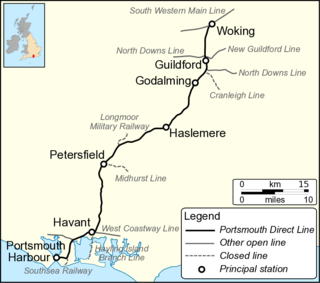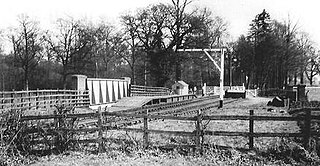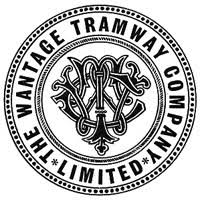
Portsea Island is a flat and low-lying natural island 24.5 square kilometres in area, just off the southern coast of Hampshire in England. Portsea Island contains the majority of the city of Portsmouth.

The West Coastway line is a railway line in England linking the conurbations of Brighton/Hove/Littlehampton and Southampton/Portsmouth, with 1.3 million people between them. It has short southward branches to Littlehampton and Bognor Regis, which offer direct services to and from London.

The Portsmouth Direct line is a railway route between Woking in Surrey and Portsmouth Harbour in Hampshire, England. It forms the principal route for passenger trains between London, Guildford and Portsmouth; connections are made to the ferry services which operate between Portsmouth and the Isle of Wight. The final section of line from Havant to Portsmouth is shared with other passenger routes.

The Arun Valley line, also known as the Mid Sussex line, is part of the Southern- and Thameslink-operated railway services. For the initial part of the route trains follow the Brighton Main Line, and at a junction south of Three Bridges the route turns westwards. It then runs via Crawley, Horsham and Arundel, before meeting the West Coastway line at Arundel Junction. Trains on the Arun Valley line then proceed to either Bognor Regis, Portsmouth & Southsea or Southampon Central

The Southsea Railway was a short railway branch line. It was built to give easier access from the jointly operated main line railway approaching Portsmouth to the Clarence Pier from which Isle of Wight ferries sailed. In 1879 the extension of the main line railway to Portsmouth Harbour station, where direct transfer from train to steamer was possible, eliminated most of the steamer business at Clarence Pier. Undeterred, promoters interested in developing Southsea projected the Southsea Railway, connecting a new Fratton station on the main line, with Southsea. The line was opened on 1 July 1885. Its independent promoters believed that it could be a main line terminus for London trains, and they constructed the line lavishly in consequence.

Littlehampton railway station is in Littlehampton in the county of West Sussex, England. The station and the trains serving it are operated by Southern.

Wood Siding railway station was a halt in Bernwood Forest, Buckinghamshire, England. It opened in 1871 as a terminus of a short horse-drawn tramway built to assist the transport of goods from and around the Duke of Buckingham's extensive estates in Buckinghamshire, as well as connect the Duke's estates to the Aylesbury and Buckingham Railway at Quainton Road.

East Southsea was the name of two terminus railway stations of the 1.25 mile Southsea Railway, which linked the Southsea seaside resort with the Portsmouth Direct Line at Fratton railway station. The later 1904 station replaced an earlier, larger, grander station building, which opened as Southsea in 1885 and was renamed East Southsea in 1896.

Jessie Road Bridge Halt was an intermediate station situated on the Southsea Railway between Fratton and Albert Road Bridge Halt.

Chalcombe Road Halt was a railway station on the link line between the Great Central Railway and the Great Western Railway's Birmingham - London line, leaving the Great Central at Culworth Junction to connect with Banbury Junction. The station, which served the nearby Northamptonshire village of Chacombe, opened in 1911 and closed in 1956.

Immingham Dock electric railway station was the western terminus of the inter-urban Grimsby and Immingham Electric Railway which ran from Corporation Bridge, Grimsby with a reversal at what was euphemistically called Immingham Town.
Grimsby electric railway station was the eastern terminus of the Grimsby and Immingham Electric Railway, the western terminus being Immingham Dock, 7 miles (11 km) to the north west.

The Wantage Tramway Company was a two-mile tramway that carried passengers and freight between the Oxfordshire town of Wantage and Wantage Road Station on the Great Western Main Line in England. Formed in 1873 to link Wantage Road station with its terminus at Mill Street, Wantage the line was cheaply built parallel to what was then the Besselsleigh Turnpike, and now the A338. The tramway closed to passengers in 1925 and to goods traffic in 1945.

Wotton railway station was a small station in Buckinghamshire, England, built by the Duke of Buckingham in 1871. Part of a private horse-drawn tramway designed to carry freight from and around his lands in Buckinghamshire, Wotton station was intended to serve the Duke's home at Wotton House and the nearby village of Wotton Underwood. In 1872 the line was extended to the nearby village of Brill, converted to passenger use, equipped with steam locomotives, and renamed the Brill Tramway. In the 1880s, it was proposed to extend the line to Oxford, but the operation of the line was instead taken over by London's Metropolitan Railway.
Wantage railway station is a closed stone and brick built station located on Mill Street, Wantage in Oxfordshire on the Wantage Tramway line. The station closed fully in 1945 when Wantage Tramway ceased operations.
Abingdon Road Halt railway station was built by the Great Western Railway to serve South Hinksey, a village near Oxford.

Trumpers Crossing Halte was a station of scant construction on the Brentford Branch Line of the Great Western Railway, which ran from Southall to Brentford Dock.

Holland Road Halt was a railway station in Hove, East Sussex, which opened in 1905 and closed in 1956. It lay to the west of the original Hove station (1840–1880) and to the east of the current station of that name (1865–present) as well as the Cliftonville Curve. It was mainly used during rush hours by stopping trains to Worthing.

The Portsmouth and Ryde Joint Railway was a group of three railway lines in Southern England that were jointly owned and operated by the London and South Western Railway and the London, Brighton and South Coast Railway. The main line was between Cosham and Portsmouth Harbour; there was a branch from Fratton to East Southsea; and a line between Ryde Pier Head and Ryde St John's Road. The last-named section was isolated from the others, being on the Isle of Wight. The first section of line opened in 1847 and the last in 1885; the Southsea branch closed in 1914 but all of the other routes have since been electrified and remain open.
The Portsmouth to Brighton Railway was built by the London, Brighton and South Coast Railway and its immediate predecessor in several stages.














